Why the Best Indoor Plants for Low Light Apartments Are a Must-Have
If you’re searching for ways to bring life into your dimly lit apartment, you’ve come to the right place. Finding the best indoor plants for low light apartments can transform even the darkest corners into vibrant, green spaces. Many urban dwellers struggle with limited natural light, but the good news is that there are plenty of hard-to-kill plants perfectly suited for low light apartments.
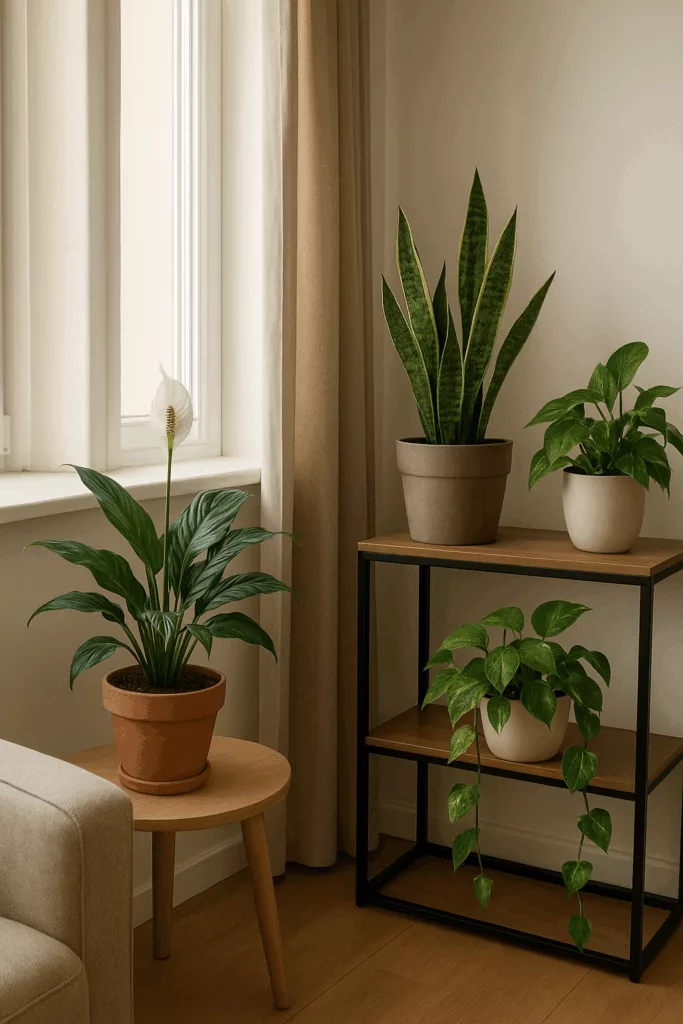
In this comprehensive guide, you’ll learn:
- How to identify the best indoor plants for low light apartments based on your space’s unique conditions.
- Detailed care guides for 10 of the most resilient and visually appealing plants.
- Common mistakes that can harm your low light apartment plants and how to avoid them.
- Creative decorating ideas to maximize the impact of the best indoor plants for low light apartments in small spaces.
- Expert tips for maintaining healthy plants with minimal effort.
Whether you’re a busy professional, a plant beginner, or someone who has struggled to keep plants alive in the past, this guide will help you create a thriving indoor garden with the best indoor plants for low light apartments.
Understanding Light Levels: How to Choose the Best Indoor Plants for Low Light Apartments
Before selecting your plants, it’s essential to assess the light conditions in your apartment. The best indoor plants for low light apartments thrive in specific light ranges, so understanding your space will help you make the best choices.
Types of Indoor Light
- Low Light: Rooms with small windows, north-facing windows, or areas far from natural light. Shadows are faint or nonexistent.
- Medium Light: East-facing windows or rooms with sheer curtains. Shadows are soft and diffused.
- Bright Indirect Light: West or south-facing windows with no direct sun. Shadows are sharp but not dark.
Tools to Measure Light Intensity
- Light Meter Apps: Use apps like Lux Light Meter to measure foot-candles (fc) or lux in different areas of your apartment.
- Low light: 25–100 fc (250–1,000 lux)
- Medium light: 100–500 fc (1,000–5,000 lux)
- Bright indirect light: 500–1,000 fc (5,000–10,000 lux)
- Hand Shadow Test: Place your hand 12 inches from a white wall. If the shadow is faint or invisible, you have low light.
Factors Affecting Light in Your Apartment
- Window Orientation: North-facing windows receive the least light.
- Obstructions: Buildings, trees, or awnings can block sunlight.
- Wall Colors: Light-colored walls reflect more light, benefiting the best indoor plants for low light apartments.
Pro Tip: If your apartment has extremely low light, consider supplementing with LED grow lights to help your low light apartment plants thrive.
Check our top 5 grow lights for indoor plants.
Top 10 Best Indoor Plants for Low Light Apartments
These hard-to-kill plants are perfect for beginners and busy individuals. Each comes with detailed care instructions, decorating tips, and common pitfalls to avoid.
1. Snake Plant (Sansevieria trifasciata)
Why It’s One of the Best Indoor Plants for Low Light Apartments: The snake plant, also known as “mother-in-law’s tongue,” is nearly indestructible. It thrives in low light, tolerates drought, and purifies the air by removing toxins like formaldehyde and benzene. NASA’s Clean Air Study named it one of the best indoor plants for low light apartments.
- Light Needs: Low to bright indirect light.
- Watering: Every 2–3 weeks (let soil dry completely between waterings).
- Bonus: Releases oxygen at night, making it ideal for bedrooms.
- Decorating Idea: Place in a modern ceramic pot near a dark corner or entryway for a sleek look.
Common Mistake: Overwatering. Snake plants prefer dry soil—always check for dryness before watering.
2. ZZ Plant (Zamioculcas zamiifolia)
Why It’s a Must-Have for Low Light Apartments: The ZZ plant is the ultimate survivor. Its glossy, waxy leaves store water, allowing it to go months without watering. It’s perfect for busy professionals or forgetful plant owners, making it one of the best indoor plants for low light apartments.
- Light Needs: Low to bright indirect light.
- Watering: Every 3–4 weeks (even less in winter).
- Bonus: Resistant to pests and diseases.
- Decorating Idea: Pair with a minimalist planter in an office or living room for a contemporary vibe.
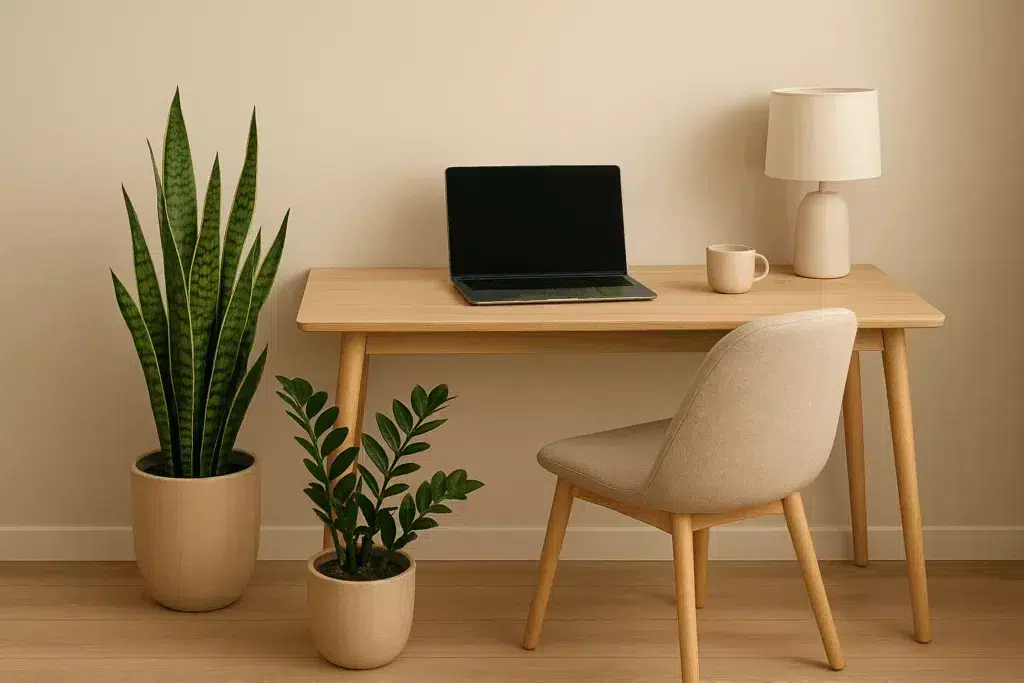
Pro Tip: The ZZ plant grows slowly, so it won’t outgrow its space quickly—ideal for small apartments.
3. Pothos (Epipremnum aureum)
Why It’s Among the Best Indoor Plants for Low Light: Pothos is a fast-growing, trailing vine that thrives in low light and is incredibly forgiving. It’s one of the easiest plants to propagate, making it a favorite for beginners and one of the best indoor plants for low light apartments.
- Light Needs: Low to bright indirect light.
- Watering: When the top 1–2 inches of soil are dry.
- Bonus: Can grow in water or soil, making it versatile for jars, vases, or hanging planters.
- Decorating Idea: Let it cascade from a shelf or macramé hanger for a boho-chic look.
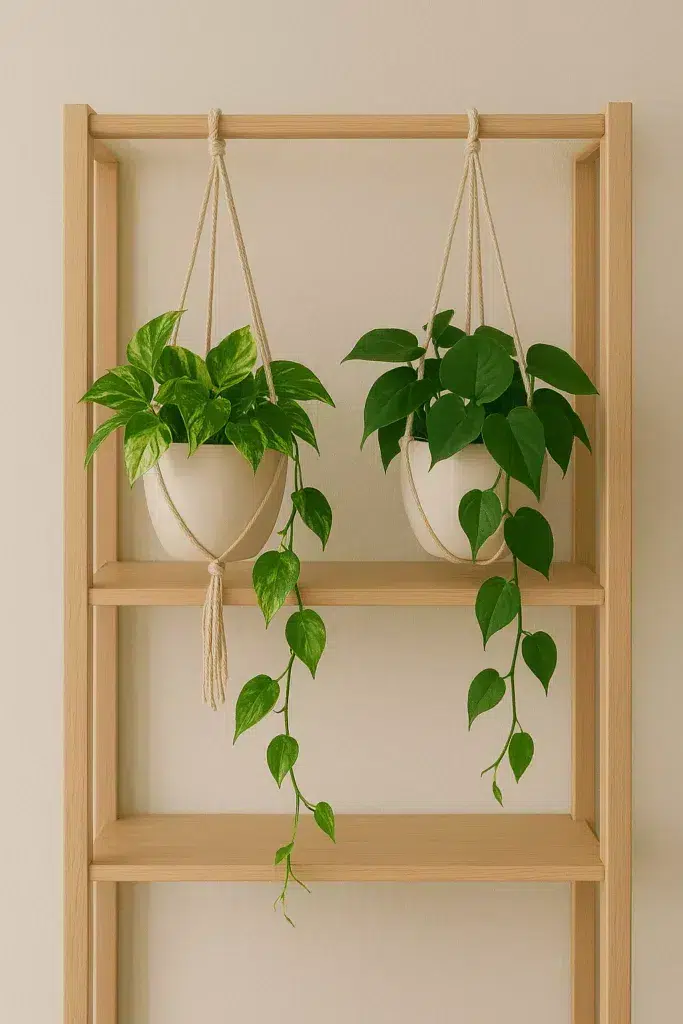
Propagation Hack: Snip a 4–6 inch stem with leaves, place in water, and watch roots grow in 2–3 weeks.
4. Peace Lily (Spathiphyllum)
Why It’s a Top Choice for Low Light Apartments: The peace lily is elegant and practical. It blooms white flowers even in low light and is one of the best air-purifying plants, according to NASA. It also thrives in humidity, making it perfect for bathrooms and one of the best indoor plants for low light apartments.
- Light Needs: Low to medium indirect light.
- Watering: Weekly (it droops dramatically when thirsty but revives quickly after watering).
- Bonus: Removes mold spores and toxins like ammonia.
- Decorating Idea: Place in a bathroom or kitchen for a pop of green and fresh flowers.
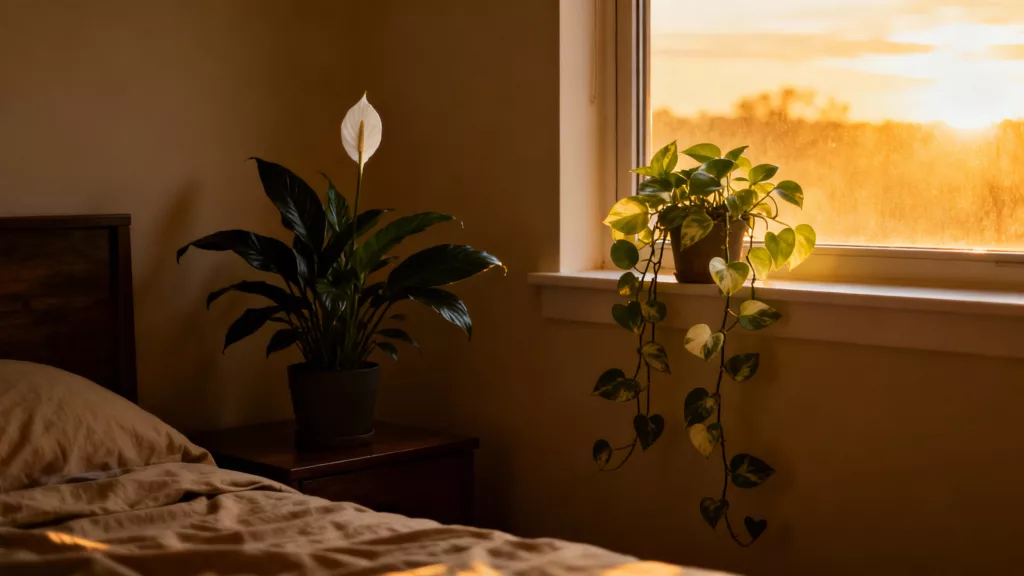
Care Tip: Wipe leaves with a damp cloth to remove dust and help it absorb more light.
5. Cast Iron Plant (Aspidistra elatior)
Why It’s a Classic Among the Best Indoor Plants for Low Light: True to its name, the cast iron plant is tough as nails. It survives neglect, low light, and temperature fluctuations, making it a staple in Victorian homes and modern apartments alike. It’s undoubtedly one of the best indoor plants for low light apartments.
- Light Needs: Low to medium light.
- Watering: Every 2–3 weeks.
- Bonus: Pet-friendly and non-toxic.
- Decorating Idea: Use in dark corners or under stairwells where other plants struggle.
Fun Fact: This plant was a favorite in 19th-century parlors because it could survive the dim, sooty air of coal-heated homes.
6. Spider Plant (Chlorophytum comosum)
Why It’s a Popular Low Light Apartment Plant: Spider plants are resilient, fast-growing, and produce “babies” (spiderettes) that you can easily propagate. They’re also non-toxic to pets, making them a great choice for households with cats or dogs and one of the best indoor plants for low light apartments.
- Light Needs: Low to bright indirect light.
- Watering: When the top inch of soil is dry.
- Bonus: Helps remove formaldehyde and xylene from the air.
- Decorating Idea: Hang in a macramé planter near a window for a playful, cascading effect.
Propagation Tip: Once spiderettes grow roots, snip and plant them in soil for free new plants!
7. Philodendron (Heartleaf or Brasil)
Why It’s a Versatile Choice for Low Light Apartments: Philodendrons are classic, easy-care plants that grow quickly and can be trained to climb or trail. They’re perfect for adding greenery to shelves, desks, or walls and are among the best indoor plants for low light apartments.
- Light Needs: Low to medium indirect light.
- Watering: When the top inch of soil is dry.
- Bonus: Available in climbing and trailing varieties.
- Decorating Idea: Train it to climb a moss pole or let it trail from a high shelf.
Styling Tip: Mix with other low-light plants for a lush, layered look.
8. Chinese Evergreen (Aglaonema)
Why It’s a Colorful Addition to Low Light Apartments: Chinese evergreens are hardy and come in vibrant patterns, adding a splash of color to dim spaces. They’re low-maintenance and adapt well to indoor conditions, making them one of the best indoor plants for low light apartments.
- Light Needs: Low to medium light.
- Watering: Every 1–2 weeks.
- Bonus: The more variegated the leaves, the more light it can tolerate.
- Decorating Idea: Use as a centerpiece on a coffee table or desk.
Care Alert: If leaves lose color, move the plant to a slightly brighter spot.
9. Parlor Palm (Chamaedorea elegans)
Why It’s a Petite Powerhouse for Low Light: This slow-growing palm is perfect for small spaces and is non-toxic to pets. It adds a tropical vibe without requiring much care and is one of the best indoor plants for low light apartments.
- Light Needs: Low to medium light.
- Watering: When the top inch of soil is dry.
- Bonus: Thrives in humidity, making it great for bathrooms.
- Decorating Idea: Place in a small corner or on a side table for a cozy, jungle-like feel.
Humidity Hack: Mist leaves occasionally or place on a pebble tray with water.
10. Dracaena (Dragon Tree)
Why It’s a Striking Option for Low Light Apartments: Dracaenas come in many varieties, all of which tolerate low light and purify the air. Their dramatic foliage makes them a statement plant in any room and one of the best indoor plants for low light apartments.
- Light Needs: Low to bright indirect light.
- Watering: Every 1–2 weeks.
- Bonus: Removes benzene, formaldehyde, and trichloroethylene.
- Decorating Idea: Use as a focal point in a living room or office.
Warning: Avoid overwatering—root rot is the only thing that can kill it.
Common Mistakes That Kill the Best Indoor Plants for Low Light Apartments
Even the hardiest low-light plants can struggle if you make these common mistakes:
1. Overwatering
Problem: Most best indoor plants for low light apartments prefer dry soil. Overwatering leads to root rot, the #1 killer of houseplants.
Solution: Always check the top 1–2 inches of soil before watering. If it’s moist, wait.
2. Ignoring Dust on Leaves
Problem: Dust blocks light absorption, slowing growth.
Solution: Wipe leaves gently with a damp cloth every few weeks.
3. Using the Wrong Soil
Problem: Heavy, compacted soil retains too much moisture.
Solution: Use a well-draining potting mix (add perlite or sand if needed).
4. Not Rotating Plants
Problem: Plants grow toward the light, leading to lopsided growth.
Solution: Rotate your best indoor plants for low light apartments every few months for even exposure.
5. Skipping Drainage Holes
Problem: Without drainage, excess water pools at the bottom, causing root rot.
Solution: Always use pots with drainage holes, or add a layer of pebbles to decorative pots.
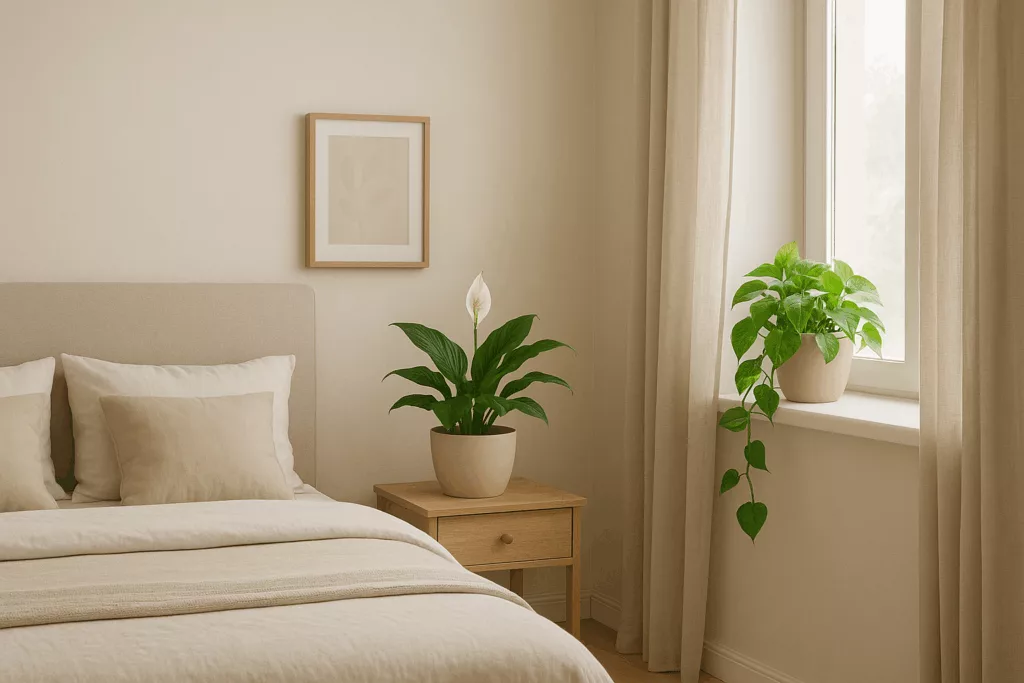
Advanced Care Tips for the Best Indoor Plants for Low Light Apartments
1. Humidity Matters
Many best indoor plants for low light apartments (like peace lilies and philodendrons) originate from tropical environments and thrive in humidity. If your apartment is dry:
- Mist leaves 1–2 times a week.
- Use a pebble tray (fill a tray with pebbles and water, place the pot on top).
- Run a small humidifier near your plants.
2. Fertilizing Smartly
The best indoor plants for low light apartments grow slowly and need less fertilizer than sun-loving plants.
- Frequency: Every 2–3 months in spring/summer.
- Type: Use a balanced, water-soluble fertilizer (diluted to half strength).
3. Pruning for Health and Aesthetics
Regular pruning encourages bushier growth and removes dead or yellowing leaves.
- How to Prune: Use clean, sharp scissors to cut just above a leaf node.
- When to Prune: Spring or early summer for best results.
4. Repotting with Care
The best indoor plants for low light apartments generally need repotting every 2–3 years.
- Signs It’s Time: Roots growing out of the drainage hole, soil drying too quickly.
- Pot Size: Choose a pot only 1–2 inches larger in diameter.
Creative Ways to Style the Best Indoor Plants for Low Light Apartments
1. Hanging Planters
- Best Plants: Pothos, spider plant, philodendron.
- Why It Works: Saves floor space and adds visual interest at eye level.
2. Shelf Displays
- Best Plants: Snake plant, ZZ plant, small dracaenas.
- Why It Works: Creates a mini indoor garden and maximizes vertical space.
3. Terrariums
- Best Plants: Fittonia, moss, small ferns.
- Why It Works: Self-contained ecosystems that require minimal care.
4. Bathroom Oasis
- Best Plants: Peace lily, cast iron plant, philodendron.
- Why It Works: High humidity and low light make bathrooms ideal for tropical plants.
5. Office Desk Companions
- Best Plants: ZZ plant, snake plant, small pothos.
- Why It Works: Boosts productivity and purifies the air in your workspace.
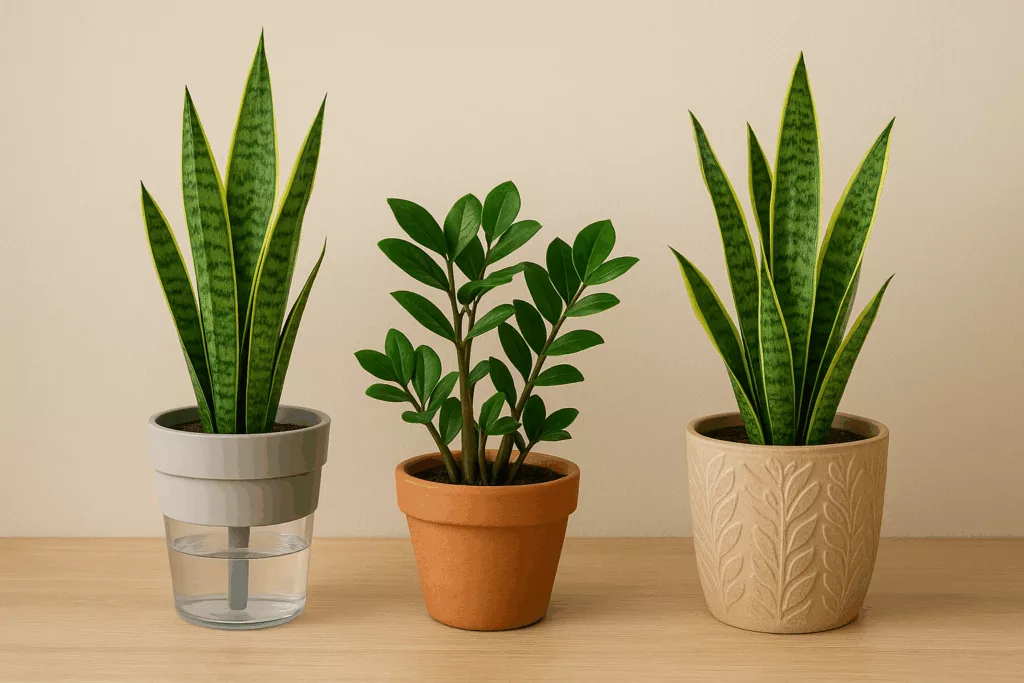
Case Study: Transforming a Dark Apartment with the Best Indoor Plants for Low Light
Scenario: A 500 sq. ft. north-facing apartment with minimal natural light. Goal: Create a green, inviting space without overwhelming the small area.
Plant Choices:
- Entryway: Snake plant (tall, architectural, air-purifying).
- Living Room: ZZ plant and pothos (low maintenance, stylish).
- Bedroom: Peace lily and cast iron plant (pet-friendly, air-purifying).
- Bathroom: Philodendron (loves humidity).
Results:
- The apartment feels cozier and more vibrant.
- Air quality improved, especially in the bedroom.
- Plants thrived with minimal care (watering every 2–3 weeks).
Lesson: Even in a dark apartment, the right best indoor plants for low light apartments can transform the space and improve your quality of life.
FAQs About the Best Indoor Plants for Low Light Apartments
Can the best indoor plants for low light apartments survive in a windowless room?
Yes! Snake plants and ZZ plants can survive in rooms with only artificial light. For best results, use a grow light for 10–12 hours a day.
How often should I water my best indoor plants for low light apartments?
Most need water every 1–3 weeks. Always check soil moisture before watering—stick your finger 1 inch into the soil. If it’s dry, it’s time to water.
Are the best indoor plants for low light apartments safe for pets?
Some are, some aren’t. Safe options: Spider plant, parlor palm, cast iron plant. Avoid: Lilies, philodendrons, and pothos (toxic if ingested).
Can I grow herbs in low light?
Most herbs need more light, but mint and parsley can tolerate lower light. For more options, check out our guide to best herbs to grow indoors for beginners.
Why are the leaves on my best indoor plants for low light apartments turning yellow?
Yellow leaves usually indicate overwatering or poor drainage. Check soil moisture and ensure your pot has drainage holes. If the soil is soggy, let it dry out before watering again.
How do I know if my best indoor plants for low light apartments are getting enough light?
Signs of insufficient light include:
– Leggy growth (long stems with sparse leaves).
– Slow or no growth.
– Leaves turning pale or yellow. If you notice these, move your plant to a brighter spot or supplement with a grow light.
Final Thoughts: Start Your Indoor Jungle with the Best Indoor Plants for Low Light Apartments
Transforming your apartment with the best indoor plants for low light apartments is easier than you think. Start with one or two hardy plants, like a snake plant or ZZ plant, and watch your space come to life. Remember, the key to success is patience and consistency—even the most resilient low light apartment plants need a little love.
Ready to green up your space? Pick your favorite plant from this list, follow our care tips, and start your indoor garden today. For more inspiration, check out our indoor gardening ideas for small apartments.
Your apartment (and your lungs) will thank you! 🌱
